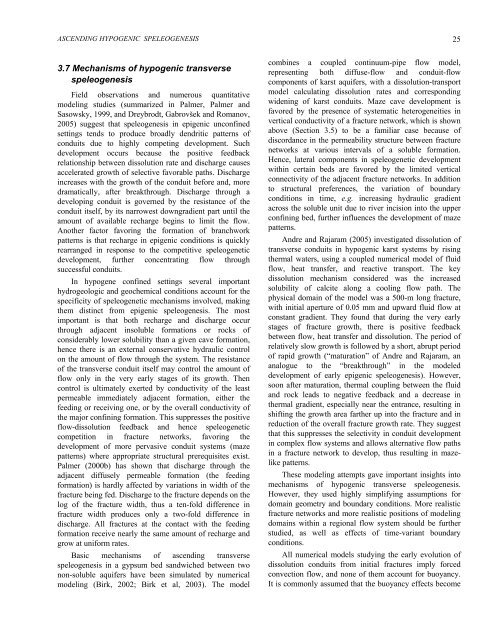Download PDF - Speleogenesis
Download PDF - Speleogenesis
Download PDF - Speleogenesis
Create successful ePaper yourself
Turn your PDF publications into a flip-book with our unique Google optimized e-Paper software.
ASCENDING HYPOGENIC SPELEOGENESIS<br />
3.7 Mechanisms of hypogenic transverse<br />
speleogenesis<br />
Field observations and numerous quantitative<br />
modeling studies (summarized in Palmer, Palmer and<br />
Sasowsky, 1999, and Dreybrodt, Gabrovšek and Romanov,<br />
2005) suggest that speleogenesis in epigenic unconfined<br />
settings tends to produce broadly dendritic patterns of<br />
conduits due to highly competing development. Such<br />
development occurs because the positive feedback<br />
relationship between dissolution rate and discharge causes<br />
accelerated growth of selective favorable paths. Discharge<br />
increases with the growth of the conduit before and, more<br />
dramatically, after breakthrough. Discharge through a<br />
developing conduit is governed by the resistance of the<br />
conduit itself, by its narrowest downgradient part until the<br />
amount of available recharge begins to limit the flow.<br />
Another factor favoring the formation of branchwork<br />
patterns is that recharge in epigenic conditions is quickly<br />
rearranged in response to the competitive speleogenetic<br />
development, further concentrating flow through<br />
successful conduits.<br />
In hypogene confined settings several important<br />
hydrogeologic and geochemical conditions account for the<br />
specificity of speleogenetic mechanisms involved, making<br />
them distinct from epigenic speleogenesis. The most<br />
important is that both recharge and discharge occur<br />
through adjacent insoluble formations or rocks of<br />
considerably lower solubility than a given cave formation,<br />
hence there is an external conservative hydraulic control<br />
on the amount of flow through the system. The resistance<br />
of the transverse conduit itself may control the amount of<br />
flow only in the very early stages of its growth. Then<br />
control is ultimately exerted by conductivity of the least<br />
permeable immediately adjacent formation, either the<br />
feeding or receiving one, or by the overall conductivity of<br />
the major confining formation. This suppresses the positive<br />
flow-dissolution feedback and hence speleogenetic<br />
competition in fracture networks, favoring the<br />
development of more pervasive conduit systems (maze<br />
patterns) where appropriate structural prerequisites exist.<br />
Palmer (2000b) has shown that discharge through the<br />
adjacent diffusely permeable formation (the feeding<br />
formation) is hardly affected by variations in width of the<br />
fracture being fed. Discharge to the fracture depends on the<br />
log of the fracture width, thus a ten-fold difference in<br />
fracture width produces only a two-fold difference in<br />
discharge. All fractures at the contact with the feeding<br />
formation receive nearly the same amount of recharge and<br />
grow at uniform rates.<br />
Basic mechanisms of ascending transverse<br />
speleogenesis in a gypsum bed sandwiched between two<br />
non-soluble aquifers have been simulated by numerical<br />
modeling (Birk, 2002; Birk et al, 2003). The model<br />
combines a coupled continuum-pipe flow model,<br />
representing both diffuse-flow and conduit-flow<br />
components of karst aquifers, with a dissolution-transport<br />
model calculating dissolution rates and corresponding<br />
widening of karst conduits. Maze cave development is<br />
favored by the presence of systematic heterogeneities in<br />
vertical conductivity of a fracture network, which is shown<br />
above (Section 3.5) to be a familiar case because of<br />
discordance in the permeability structure between fracture<br />
networks at various intervals of a soluble formation.<br />
Hence, lateral components in speleogenetic development<br />
within certain beds are favored by the limited vertical<br />
connectivity of the adjacent fracture networks. In addition<br />
to structural preferences, the variation of boundary<br />
conditions in time, e.g. increasing hydraulic gradient<br />
across the soluble unit due to river incision into the upper<br />
confining bed, further influences the development of maze<br />
patterns.<br />
Andre and Rajaram (2005) investigated dissolution of<br />
transverse conduits in hypogenic karst systems by rising<br />
thermal waters, using a coupled numerical model of fluid<br />
flow, heat transfer, and reactive transport. The key<br />
dissolution mechanism considered was the increased<br />
solubility of calcite along a cooling flow path. The<br />
physical domain of the model was a 500-m long fracture,<br />
with initial aperture of 0.05 mm and upward fluid flow at<br />
constant gradient. They found that during the very early<br />
stages of fracture growth, there is positive feedback<br />
between flow, heat transfer and dissolution. The period of<br />
relatively slow growth is followed by a short, abrupt period<br />
of rapid growth (“maturation” of Andre and Rajaram, an<br />
analogue to the “breakthrough” in the modeled<br />
development of early epigenic speleogenesis). However,<br />
soon after maturation, thermal coupling between the fluid<br />
and rock leads to negative feedback and a decrease in<br />
thermal gradient, especially near the entrance, resulting in<br />
shifting the growth area farther up into the fracture and in<br />
reduction of the overall fracture growth rate. They suggest<br />
that this suppresses the selectivity in conduit development<br />
in complex flow systems and allows alternative flow paths<br />
in a fracture network to develop, thus resulting in mazelike<br />
patterns.<br />
These modeling attempts gave important insights into<br />
mechanisms of hypogenic transverse speleogenesis.<br />
However, they used highly simplifying assumptions for<br />
domain geometry and boundary conditions. More realistic<br />
fracture networks and more realistic positions of modeling<br />
domains within a regional flow system should be further<br />
studied, as well as effects of time-variant boundary<br />
conditions.<br />
All numerical models studying the early evolution of<br />
dissolution conduits from initial fractures imply forced<br />
convection flow, and none of them account for buoyancy.<br />
It is commonly assumed that the buoyancy effects become<br />
25
















